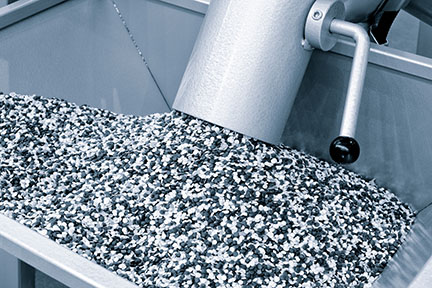As the world faces growing challenges from plastic waste, innovative technologies like plastic pyrolysis offer promising solutions. Plastic pyrolysis transforms discarded plastic into useful fuels, chemicals, and materials, helping to reduce landfill waste and support a circular economy. Enerquip is providing thermal solutions to serve the emerging plastic pyrolysis industry.
What is Plastic Pyrolysis?
Plastic pyrolysis is an advanced recycling process that heats plastic waste in the absence of oxygen, breaking it down into valuable liquid and gas products without burning it. This process, known as thermal decomposition, takes place at high temperatures—around 932 °F (500 °C)—and produces fuels like pyrolysis oil and gas. These fuels can be used in a variety of applications, including energy production and chemical manufacturing.
Unlike traditional incineration, pyrolysis reforms plastic into useful substances instead of turning it into ash or releasing harmful emissions into the atmosphere. This makes it a more sustainable option for recycling plastic waste.
The Plastic Pyrolysis Process
The plastic pyrolysis process involves several key steps:
- Shredding and Drying: Plastic waste is shredded and dried to prepare it for the pyrolysis reactor.
- Feedstock Separation: Non-plastic materials are removed to ensure pure feedstock for efficient processing.
- Thermal Decomposition: The plastic is heated in a reactor, where it vaporizes and breaks down into pyrolysis oil and gases.
- Oil Distillation and Purification: The liquid fuel produced is distilled and purified for further use.
- Storage and Dispatch: The final product is stored for distribution or immediate use.
Catalysts for Improved Efficiency
Certain catalysts can enhance the efficiency of the plastic pyrolysis process by speeding up chemical reactions and improving fuel quality. Common catalysts include:
- ZSM-5
- FCC
- MCM-41
- Zeolite
Benefits of Plastic Pyrolysis
Plastic pyrolysis offers several advantages that make it an attractive option for plastic recycling:
- Relatively Eco-Friendly: Studies show pyrolysis is more environmentally sustainable than landfilling or incinerating mixed plastic waste. The oil produced through pyrolysis replaces the need for new commercial diesel, reducing environmental impact.
- Combustion-Free: Since oxygen is absent in the pyrolysis process, no greenhouse gases are emitted from combustion. The only emissions come from the fossil fuels used to heat the reactor, which can be reduced by using the fuel produced during pyrolysis.
- Cost-Effective: The gas produced can be reused to heat the reactor, saving significant costs on external fuel.
Importance of Plastic Waste Recycling in the Chemical Industry
Plastics are not a renewable fuel source. Producing plastics and converting them into fuel releases a considerable amount of pollution that can put the health of nearby residents at risk and accelerate climate change.
However, plastic recycling reuses processed plastics, reducing the need to extract raw, new materials from the earth and preserving natural resources. In recycling applications, plastic pyrolysis can also help minimize the emission of heat-trapping gases into the atmosphere.
Properly recycling plastic waste can help prevent it from entering rivers, oceans, and ecosystems, where it can contribute to the degradation of the environment and harm wildlife. Recycling gives plastics a second purpose, preventing it from becoming a recurring pollutant.
Types of Equipment Used in the Plastic Pyrolysis Process
Shell and Tube Heat Exchangers
A shell and tube heat exchanger plays a crucial role in the pyrolysis process by managing the heat transfer between different fluids or gases. Here’s how it fits into the plastic pyrolysis system:
- Preheating the feedstock to reduce energy consumption in the reactor.
- Cooling pyrolysis vapors to condense them into liquid products like pyrolysis oil.
- Recovering heat to increase energy efficiency.
- Stabilizing reactor temperature for optimal performance.

Enerquip Heat Exchangers for a Pyrolysis Application
Pyrolysis Oil Burners
While an industrial pyrolysis oil burner is considered optional, the equipment is typically necessary since the pyrolysis oil can be used as fuel to heat the pyrolysis reactor. This eliminates the need to purchase fuel from other sources, resulting in convenience and cost-saving benefits.
Carbon Black Screw Conveyors
Following discharge from the pyrolysis reactor, carbon black must be carried away by screw conveyors. These specialized conveyors help save time and labor.
Environmental Protection Devices
A tail gas purification system is used to purify the tail gas produced during the pyrolysis process. Most pyrolysis plants also maintain a flue gas desulfurization tower as part of their standard flue gas purification system. If there is a greater need for environmental protection, custom configurations are available to meet those needs.
Auto-Feeders
An auto-feeder improves the efficiency of feeding plastic into a pyrolysis reactor. By automatically pressing the plastics into the reactor at high pressures, auto-feeders can significantly reduce the amount of time and effort needed for feeding compared to manual labor.
Vacuum Systems
Once the plastic pyrolysis process is complete, a vacuum system extracts the remaining oil from the reactor to prevent the oil from causing a fire when the reactor door opens.
Plastic Pyrolysis vs. Mechanical Recycling
Chemical Recycling
Chemical recycling encompasses reprocessing technologies, such as industrial pyrolysis, that directly affect the formulation of the polymer or the polymeric waste. Chemical recycling converts the polymer into chemical substances or products for either its original purpose or other purposes, except for energy recovery.
Mechanical Recycling
Also known as physical recycling, mechanical recycling involves processing plastic materials without altering their original chemical structure. The plastics are subject to various processes, such as melting and grinding, that alter the materials’ physical form. Without breaking any polymeric chains, these steps aim to purify the material for reuse.
Enerquip: Your Partner in Plastic Pyrolysis Solutions
Since 1985, Enerquip has been a leader in providing industrial heating and cooling solutions. All of our products are manufactured in the U.S. from our carbon-neutral facilities in Wisconsin and Oklahoma. We continuously explore new and emerging technologies to enhance sustainability, from biofuel blending to landfill gas recycling—and now, plastic pyrolysis.
Request a quote today to see how our equipment can serve your process application.

